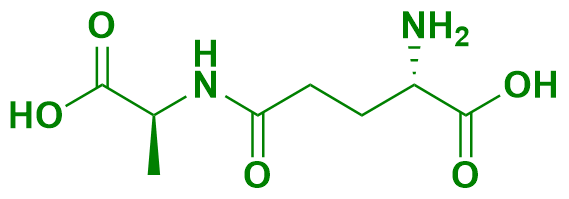γ-Glutamylalanine Analysis Service
- Identification of new disease markers
- Improvement of disease diagnosis
- Acceleration of the development of novel therapeutics
- Elucidation of new insights into disease pathways
- Animal tissue ≥ 100 mg
- Plant tissue ≥ 200 mg
- Serum/ Plasma ≥ 200 μL
- Urine ≥ 2 mL
γ-Glutamylalanine is a dipeptide composed of glutamic acid and alanine, possessing significant biological functions. It is involved not only in protein synthesis within living organisms but also plays a role in intracellular signaling and metabolic regulation. The levels of γ-glutamylalanine can reflect the metabolic state of cells, particularly in response to environmental stress and nutritional changes. γ-Glutamylalanine can be hydrolyzed by enzymatic action into glutamic acid and alanine or further converted into other amino acids and small molecules. These metabolites exhibit antioxidant properties, protecting cells from oxidative damage. Glutamic acid is an important neurotransmitter that participates in signal transmission in the nervous system, influencing neural function. By monitoring the levels of γ-glutamylalanine and its metabolites, it can serve as a biomarker for plants and animals in response to adversity, aiding in the improvement of adaptability and stress resistance in organisms.

Figure 1. The Structure of γ-Glutamylalanine
Mass spectrometry-based metabolomics methods can simultaneously detect and quantify thousands of metabolic features and are widely used for the metabolic analysis of various compounds. MtoZ Biolabs utilizes an LC-MS-based metabolomics research platform for the analysis of γ-glutamylalanine. We ensure the accuracy of the quantification of γ-glutamylalanine and its metabolites, as well as the comprehensiveness and precision of metabolite identification. If you would like to learn more about our γ-glutamylalanine analysis services, please feel free to contact us, and we will be more than happy to assist you.
Analysis Workflow
Service Advantages
1. Experienced: MtoZ Biolabs has a professional research team and advanced technical equipment, capable of providing high-quality services and support to meet the specific needs of clients.
2. Wide Applicability: It is suitable for various types of samples, including plants, animals, and biological fluids, making it applicable across a broad range of fields.
3. High Throughput: Mass spectrometry technology can analyze multiple metabolites simultaneously in a short time, making it suitable for high-throughput analysis of large-scale samples.
4. Targeted Compounds: Targeted metabolomics focuses on specific metabolites, effectively eliminating interference signals and enhancing the reliability of the data.
5. Strong Detection Capability: Mass spectrometry technology can detect low concentrations of metabolites, making it suitable for analyzing rare or complex components in biological samples.
Applications
Sample Submission Requirements
1. Sample Types
Serum, plasma, urine, tissues, and other biological samples. It is necessary to select more than 3 materials with the same condition for each sample.
2. Sample Volume
3. Sample Preservation
Store at -80°C to maintain stability.
Note: Please provide details on sample collection and handling.
Deliverables
1. Experimental Procedures
2. Relevant Liquid Chromatography and Mass Spectrometry Parameters
3. Detailed Information on γ-Glutamylalanine
4. Raw Data
5. Custom Analysis Report
With our γ-glutamylalanine analysis service, we endeavor to support your research and product development ventures by supplying precise and dependable results. Trust MtoZ Biolabs for your γ-glutamylalanine analysis needs.
How to order?







